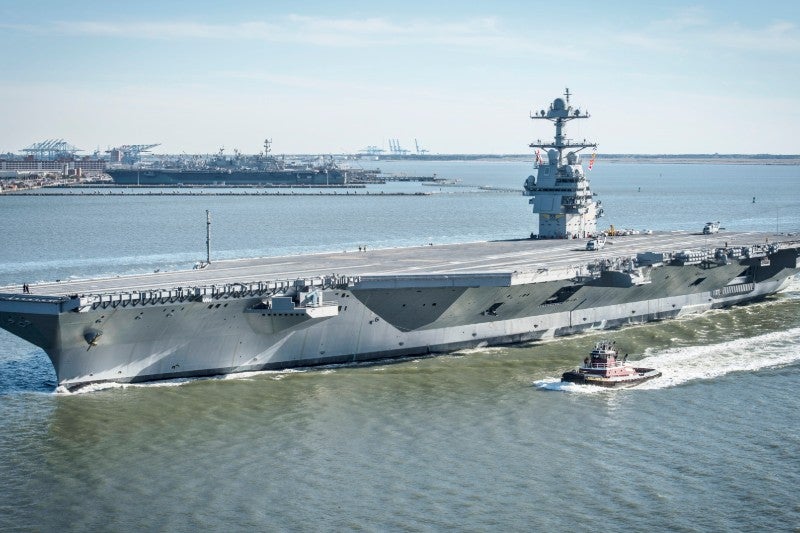
The US and China have been working on new future aircraft carriers to enhance their respective navies. The US has more than 70 years’ experience developing aircraft carriers while China has been working on aircraft carriers for six years. Operating at full capacity, aircraft carriers can launch and recover up to 240 aircraft per day.
The US’s Gerald R Ford class (Ford class), built by Newport News Shipbuilding, has been under construction since 2005. The first vessel – the USS Gerald R Ford – was commissioned in July 2017 and is expected for deployment by 2022. Four more vessels are currently in various stages of completion, with commission dates set between 2024 and 2034.
How well do you really know your competitors?
Access the most comprehensive Company Profiles on the market, powered by GlobalData. Save hours of research. Gain competitive edge.

Thank you!
Your download email will arrive shortly
Not ready to buy yet? Download a free sample
We are confident about the unique quality of our Company Profiles. However, we want you to make the most beneficial decision for your business, so we offer a free sample that you can download by submitting the below form
By GlobalDataMeanwhile, the People’s Liberation Army Navy (PLAN) of China has been constructing a new, domestically built aircraft carrier class, built by Dalian Industry Shipbuilding Company. After successful completion of its fifth sea trial in February and March 2019, the first Type 001A class is expected to enter service by the end of the year.
How do these two future aircraft carriers compare on key metrics such as size, speed, armament and cost?
Aircraft capacity and size
Aircraft carriers are the largest warships in the naval fleet, unsurprisingly, as they need a lot of deck room.
The USS Gerald R Ford can carry more than 75 aircraft while the future aircraft carriers – the USS Enterprise and USS John F Kennedy – can carry up to 90 combat aircraft. As such, the Ford-class vessels are colossal, weighing 100,000t and have a length of 337m and a beam (flight deck) of 78m.
China’s first home-grown array of future aircraft carriers, the Type 001A class, has the capacity to hold 38-40 aircraft in total, around half the capacity of the US’s Ford class. Interestingly, the Type 001A is slightly smaller at 315m with a beam (flight deck) of 71m. It has the advantage of only weighing 70,000t at full load.
Speed and power
Speed is an important metric for aircraft carriers, as they often need to be deployed anywhere in the world quickly, and must be fast enough to evade detection and targeting by enemy forces.
While the Ford class can travel at speeds of 30kn (55.6km/h), China’s Type 001A is slightly faster at 31kn (57.4km/h), just under 2km/h quicker. However, when taking into account the fact that the Type 001A weights 30,000t less, the slight improvement in speed is not so impressive.
In order to shift such a weight at speed, the US’s Ford class is powered by two A1B nuclear reactors, which can create a total of 700MW of electricity. This equates to a 25% increase on the predecessor – the Nimitz class. The Nimitz-class aircraft carriers were designed using A4W reactors, which were regarded as insufficient to power the modern systems designed for the Ford class.
On the other hand, China’s Type 001A uses conventional steam turbines with diesel generators. These are known to be more cost-efficient, due to the low prices of diesel, but travel at generally lower speeds than nuclear-powered vessels.
Armaments
Aircraft carriers need defensive capabilities to protect the multitude of aircraft and thousands of crew on-board. The US Ford-class aircraft carriers come equipped with two RIM-162 Evolved SeaSparrow missile launchers and RIM-166 RAM surface-to-air missiles. Future aircraft carriers of the Ford class can be upgraded with lasers and energy dissipating armour systems to protect against high-speed GPS-guided missiles.
“Defence against high-speed, GPS-guided missiles will require faster defensive weapons, such as laser guns, and energy dissipating armour systems, such as dynamic armour should the smart weapons get past the lasers,” said the RAND institute in a 2005 report.
“CVN 21 [Ford class designation] will be in a good position to accept these defensive systems. CVN 21 will thus have the power reserves that the Nimitz class lacks to run lasers and dynamic armour.”
Furthermore, the Ford class comes with three Phalanx close-in weapons systems (CIWS), each equipped with four M2 50cal machine guns.
The Type 001A class uses three Type 1130 CIWS, the same system used on the previous Liaoning aircraft carrier. One Type 1130 incorporates 11 barrels, is said to possess a firing rate of 11,000 rounds per minute and is reported to intercept anti-ship missiles with speeds of up to Mach 4 with a success rate of no less than 96%, according to Navy Recognition.
China’s future aircraft carriers also come with three HHQ-10 surface-to-air missile systems with 18 cells each. The HHQ-10 system can operate with full autonomy and has a reaction time of around 6-8 seconds.
Cost
While unit costs of vessels typically vary, China’s Type 001A-class programme is estimated to cost $9bn for two vessels.
In contrast, the entire US Ford-class programme was estimated to cost $37.3bn. Of this, the first ship of this class – the USS Gerald R Ford – was estimated by Congress to cost $12.8bn with an additional $4.7bn in research and development costs. The second ship, the USS John F Kennedy, will be slightly cheaper, at $11.3bn.
In terms of cost then, the Chinese Type 001A vessels are much cheaper, at around one-third of the price of their US counterparts.
It seems that the US Ford-class aircraft carriers will outmatch the Chinese Type 001A-class vessels in all areas, except the Chinese ship is slightly faster. However, the US Government seems to be paying a premium for its future aircraft carriers, which will ultimately have a greater impact on its defence budget.








